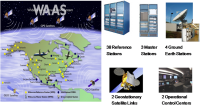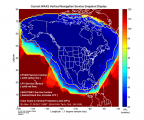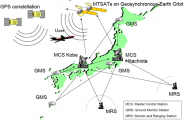If you wish to contribute or participate in the discussions about articles you are invited to contact the Editor
GBAS Systems: Difference between revisions
| Line 18: | Line 18: | ||
The [http://www.faa.gov/about/office_org/headquarters_offices/ato/service_units/techops/navservices/gnss/laas/ Local Area Augmentation System (LAAS)] is designed to correct some of the errors inherent to GPS. One problem is the lack of a real-time, rapid-response monitoring system. Category I equipment will normally alert the user of the problem within ten seconds of detecting a problem. GPS has no such rapid-warning system. For example, if a develops a clock problem, there is no way to rapidly warn the user not to use that satellite. [[WAAS]], LAAS and other differential solutions fix this problem and provide GPS system integrity. Another problem is positional accuracy. Sources of error such as satellite or ionospheric delays can introduce several meters of error in an aircraft's position. These errors must be corrected in real time for a precision approach where there is little or no visibility. | The [http://www.faa.gov/about/office_org/headquarters_offices/ato/service_units/techops/navservices/gnss/laas/ Local Area Augmentation System (LAAS)] is designed to correct some of the errors inherent to GPS. One problem is the lack of a real-time, rapid-response monitoring system. Category I equipment will normally alert the user of the problem within ten seconds of detecting a problem. GPS has no such rapid-warning system. For example, if a develops a clock problem, there is no way to rapidly warn the user not to use that satellite. [[WAAS]], LAAS and other differential solutions fix this problem and provide GPS system integrity. Another problem is positional accuracy. Sources of error such as satellite or ionospheric delays can introduce several meters of error in an aircraft's position. These errors must be corrected in real time for a precision approach where there is little or no visibility. | ||
[http:// | [http://www51.honeywell.com/honeywell/news-events/press-releases-details/9.21.09SmartPath.html?c=31 Honeywell] has developed a Non-Federal CAT-1 LAAS which received System Design Approval (SDA) from the [http://www.faa.gov/ Federal Aviation Administration (FAA)] in September 2009[1] Current proposed installations include: airports in Newark, NJ; Memphis, TN; Atlantic City, NJ; and Olathe, KS. | ||
==[[WAAS]]== | ==[[WAAS]]== | ||
Revision as of 14:45, 19 May 2011
| Fundamentals | |
|---|---|
| Title | GBAS Systems |
| Author(s) | GMV |
| Level | Basic |
| Year of Publication | 2011 |
A Ground-Based Augmentation System (GBAS) is a civil-aviation safety-critical system that supports local augmentation – at airport level – of the primary GNSS constellation(s) by providing enhanced levels of service that support all phases of approach, landing, departure and surface operations.
Only one operational GBAS system is available at the moment:
-The United States' Local Area Augmentation System (LAAS)
Local Area Augmentation System (LAAS)
The Local Area Augmentation System (LAAS) is designed to correct some of the errors inherent to GPS. One problem is the lack of a real-time, rapid-response monitoring system. Category I equipment will normally alert the user of the problem within ten seconds of detecting a problem. GPS has no such rapid-warning system. For example, if a develops a clock problem, there is no way to rapidly warn the user not to use that satellite. WAAS, LAAS and other differential solutions fix this problem and provide GPS system integrity. Another problem is positional accuracy. Sources of error such as satellite or ionospheric delays can introduce several meters of error in an aircraft's position. These errors must be corrected in real time for a precision approach where there is little or no visibility.
Honeywell has developed a Non-Federal CAT-1 LAAS which received System Design Approval (SDA) from the Federal Aviation Administration (FAA) in September 2009[1] Current proposed installations include: airports in Newark, NJ; Memphis, TN; Atlantic City, NJ; and Olathe, KS.
WAAS
The Wide Area Augmentation System (WAAS) was jointly developed by the United States Department of Transportation (DOT) and the Federal Aviation Administration (FAA), beginning in 1994, to provide performance comparable to category I instrument landing system (ILS) for all aircraft possessing the appropriately certified equipment.[1]
On July 10, 2003, the WAAS signal was activated for safety-of-life aviation, covering 95% of the United States, and portions of Alaska.[1] At present, WAAS supports en-route, terminal and approach operations down to a full LPV-200 (CAT-I like Approach Capability) for the CONUS, Mexico and Canada.
MSAS
The Multi-functional Satellite Augmentation System (MSAS) is the Japanese SBAS. NEC manufactured and delivered MSAS under contract with the Civil Aviation Bureau, Ministry of Land, Infrastructure, Transport and Tourism.
MSAS is operational since 2007 supporting en-route, terminal and non-precision approach operations (RNP 0.1). Recently has completed successful LPV flight trials.
GAGAN
The GPS Aided Geo Augmented Navigation or GPS and Geo Augmented Navigation system (GAGAN) is the SBAS implementation by the Indian government. The Indian government states that it will use the experience of building the GAGAN system in the creation of an autonomous regional navigation system called the Indian Regional Navigational Satellite System (IRNSS).[2]
The final, operational phase of GAGAN is likely to be completed in 2011.[2]
GAGAN overview.[2]
SDCM
The System for Differential Corrections and Monitoring (SDCM) is the SBAS currently being developed in the Russian Federation. SDCM is expected to be certified in the coming years, being this just the first step in the SDCM strategy which pursues also other broadcast means –potentially a polar MEO– with the aim of providing also a service to the North part of Russia.
The main differentiator of SDCM with respect to other SBAS systems is that it is conceived as an SBAS augmentation to GPS and GLONASS, whereas the rest of current SBAS initiatives provide corrections and integrity just to GPS satellites.
- Sdcm overview.png
SDCM planned station network
SACCSA
The SBAS initiative in South/Central America and the Caribbean is called SACCSA (Soluciόn de Aumentaciόn para Caribe, Centro y Sudamérica). SACCSA is an ICAO project founded by the Participants/Member States of the SACCSA Project: Argentina, Bolivia, Colombia, Costa Rica, Guatemala, Panama, Spain, Venezuela and COCESNA (Corporación Centroamerica de Servicios de Navegación Aérea). The objective is to study the improvement of the Air Navigation Environment in the Caribbean and South America (CAR/SAM) Regions with a SBAS solution. The program began in 2003 being at present in its Phase III which will determine the feasibility of the implementation of an own SBAS system in the CAR/SAM regions.
Notes




![GAGAN overview.[2]](/navipedia/images/thumb/c/c1/Gagan_overview.png/182px-Gagan_overview.png)